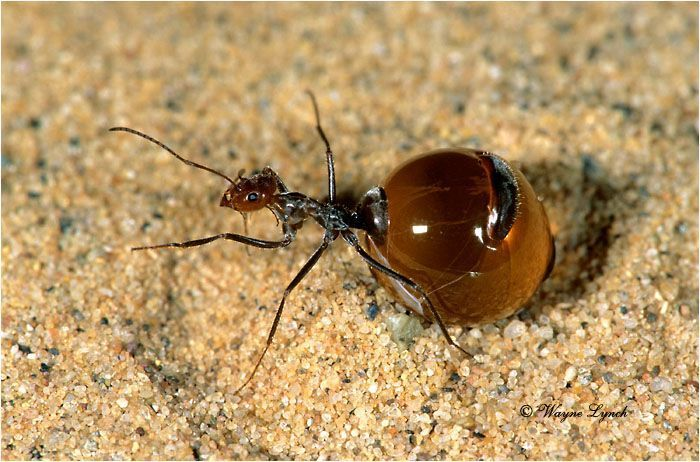Today I will be taking a look at one of my favourite ants: honeypot ants in the genera Myrmecocystus. I think you’ll agree that they earn the titles weird and wonderful.
Honey pots ants of this genus are native to North and central America. They live in very harsh environments such as Deserts where water and food can be very hard to come by. So if you are in the desert, want to store food and don’t have a freezer, how do you store food? Simple, you eat it.
In honeypot ant colonies, certain workers, known as repletes, undergo a fascinating transformation. These ants are fed by their nestmates until their abdomens swell to the size of a grape, filled with nectar, honeydew, or body fluids. The repletes serve as living storage. If you have ever eaten more than you own weight you know that you feel very fragile around your stomach area. So do they! So, to reduce the chances of being damaged by nest mates, they hang from the ceilings of their nests! When food or water is scarce during the dry seasons, other ants tap into these reserves, obtaining sustenance from the stored liquids. This adaptation allows the colony to thrive in environments where other species struggle to survive. They allow honeypot ants to survive these hard times to live another day.

Honeypot ants, like most ants, are extremely territorial. When resources are scarce, you will protect them at all costs. The repletes become one of these resources. When neighbouring ants attack their nests, the repletes are an amazing prize. They steal them into their own colonies, benefiting from the hard work of their rivals. Evolution favours aggression in this scenario. However, combat comes with risks. In an area with rare resources, each member of the colony represents a large investment of energy and resources. Sending these investments into a fight could be very costly for a colony.
So when 2 colonies of honeypot ants meet over a source of food, they engage in a fascinating display. Instead of fighting over a food source they adapt a threat display and engage in a semi-tournament. They will attempt to swarm all over the entrances of the enemy nest and engage in these tournaments, blocking them from leaving their nests and stealing the food source. This minimises deaths and the risk of losing the food invested into the production of workers. This is especially important as these interactions can involve several hundred workers from each colony. This is very similar to the Duels seen in Dinomyrmex gigas as shown below. However, if one colony is significantly larger than the other, things take a much darker approach.

The larger colony will simply raid the smaller nest. The Queen will be killed or chased away and her brood will be stolen. The eggs, larvae and pupae will be taken to the victorious nest and join her ranks. The enemy repletes, full of food and water, are dragged to the nest and used to feed the winners. Even workers of the defeated colony may join their new overlords. The territory of the larger nest expands and, depending on how vicious the fighting was, so will the size of her colony. These are very aggressive ants as being aggressive is beneficial over all.
Honeypot ants are a testament to nature’s resourcefulness, showcasing how species adapt to their environments in remarkable ways. Their ability to store food within living workers ensures their survival in harsh conditions, making them a subject of fascination and study for scientists and nature enthusiasts alike. This is why they are among my favourite ants and that really is saying something! Thanks for reading,
Alex.
If you have enjoyed this site and its content please consider becoming a Patron so I can add more content in the future.
And check out what I do and where to find me here:
https://allmylinks.com/alexants

References
Hölldobler, B. and Wilson, E.O., 1990. The ants. Harvard University Press.
“Honey Ant War Games End in Slavery.” Science News 109, no. 23/24 (1976): 358–358. https://doi.org/10.2307/3960982.
Kronauer, D.J.C., Miller, D.J. and Hölldobler, B., 2003. Genetic evidence for intra–and interspecific slavery in honey ants (genus Myrmecocystus). Proceedings of the Royal Society of London. Series B: Biological Sciences, 270(1517), pp.805-810.
Morgan, R. Biology, husbandry and display of the diurnal honey ant Myrmecocystus mendax Wheeler (Hymenoptera: Formicidae) Archived 2010-07-17 at the Wayback Machine
